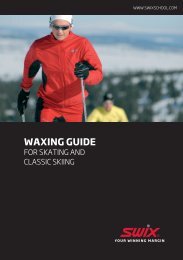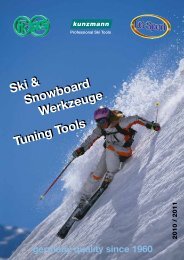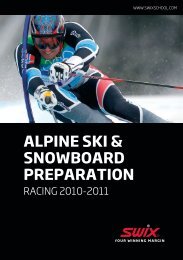NORDIC SKI PREPARATION
NORDIC SKI PREPARATION
NORDIC SKI PREPARATION
You also want an ePaper? Increase the reach of your titles
YUMPU automatically turns print PDFs into web optimized ePapers that Google loves.
BASE STRUCTURES AND<br />
SWIX RILLING / IMPRINT TOOLS<br />
Structure is a term used to describe patterns<br />
cut into the base to reduce base contact on the<br />
snow and to release surface tension from water<br />
films caused by base friction. These structure patterns<br />
are most often produced by stone grinding<br />
machines at the factory during production or by<br />
shops that specialize in the stone grinding process.<br />
It is also possible to produce structures using<br />
hand tools.<br />
For a period of time there was much experimentation<br />
and testing of many types of patterns<br />
in order to find the best structure for different<br />
snow types. The search with different stone<br />
grinders, different structure depths, widths,<br />
and patterns, all aiming to find “the ultimate<br />
structure”, was overwhelming. Recently however,<br />
the development showed signs of simplification.<br />
Now service technicians agree more that<br />
snow types can be classified in more general<br />
terms to which more certain structure patterns<br />
can be matched. An appropriate structure is still<br />
of absolute importance, but it is applied with a<br />
set of basic principles in mind. The result is that<br />
variations in machine set structures are fewer<br />
and standardized. The tendency to “simplify”<br />
variations in stone grinding can allow for a more<br />
accurate comparison of other significant factors<br />
such as skis and waxes, and in theory it is possible<br />
to travel with fewer pairs of skis.<br />
Last but not least, structures made by hand<br />
on top of structures produced by machine have<br />
proven to give outstanding results. Manually set<br />
structures in combination with stone grinding can<br />
match the day’s conditions more accurately and<br />
therefore enhance the effectiveness of a basic<br />
stone ground base.<br />
There is an important difference between<br />
structures produced by machine and those produced<br />
by hand. Stone ground structures are cut<br />
into the base, and are more permanent in nature.<br />
Hand structures use “imprint” tools that press<br />
the structure into the base, and consequently are<br />
temporary.<br />
Swix imprint tools have the advantage of<br />
being easy and quick to use while at the same<br />
time offer the most adaptability of adjusting the<br />
structure to match the snow type. During the process<br />
of rewaxing the heat from the iron will cause<br />
the pattern to leave the base while keeping the<br />
stone ground pattern intact. In this way the base<br />
is ready once again for the next hand produced<br />
structure treatment and it is possible to apply the<br />
perfectly matching structure according to the<br />
conditions of the day.<br />
Although there are variations in the patterns<br />
applied, structures can be classified into “fine”,<br />
“medium-fine”, “medium-coarse” and “coarse”<br />
structures. The most frequently used structures<br />
in World Cup are “fine” and “medium-fine”.<br />
For classic races more coarse structures are used<br />
as well. The difference between classic and skating<br />
is related to more varying conditions in a skating<br />
coarse than in a classic track. Also the factor of<br />
“feeling” that has to do with the resistance when<br />
“pushing” the ski forward is significant in skating,<br />
but less in classic. The “free feeling” can be lost,<br />
especially when skating uphill, when the structure<br />
is too coarse.<br />
Four Different Grades of<br />
Stone Grinding<br />
The Norwegian XC-team has introduced a color<br />
coding system to select corresponding skis and<br />
structure of the glide zone:<br />
Green (-5°C and colder): Fine<br />
Blue (0°C to -5°C): Medium/Fine<br />
White (0°C to+3°C - moist): Medium/Coarse<br />
Red (+1°C to +10°C - wet): Coarse<br />
It is normal to apply two or more labels on the skis.<br />
At the tip the colored labels (one or two) indicate<br />
actual snow condition range for the actual pair,<br />
i.e. green and blue. In front of the binding there<br />
is only one label, i.e. green, to indicate existing<br />
structure. For optimal performance of this pair in<br />
“blue” snow conditions, it is therefore necessary<br />
to run a hand-made structure to transform “Fine”<br />
to “Medium / Fine”. In this way, good skis might be<br />
utilized in more snow conditions. In addition, the<br />
number of skis taken to races is perhaps reduced.<br />
In free-technique (skating) the coarse structure<br />
is seldom used. Consequently, a free-technique<br />
ski for wet, coarse-grained snow often has<br />
a red label on the tip and a white label in front of<br />
the binding.<br />
Fine structures:<br />
Fine structures are mainly used on new snow and<br />
fine grained snow. For skating; fine structures are<br />
normally used from 0°C (32°F) and colder, for classic;<br />
-5°C (23°F) and colder.<br />
Sharp crystals (present in dry new/fine snow)<br />
and a sharp structure is not optimal. A newly<br />
set (fresh) structure will in general give a<br />
“sharp” structure. In dry, cold, new and fine<br />
snow conditions (usually lower than -7°C<br />
(19°F)), the fine “sharp” structure should be<br />
“rounded” with Fibertex T264 (or a plexi scraper).<br />
Though, this process is normally more important<br />
for skating than for classic skiing. On the other<br />
hand, in new snow with high humidity close to 0°C<br />
(32°F) the structure should preferably be sharper.<br />
Medium/Fine structures:<br />
This structure is a widely used structure.<br />
For skating it is used in most snow conditions<br />
normally from -7°C (19°F) up to wet snow.<br />
In very wet conditions a medium/fine structure<br />
combined with the use of an imprint tool has<br />
proven good results.<br />
For classic skiing we recommend this structure<br />
in new and fine grained snow (normally<br />
between -7°C (19°F) and 0°C (32°F)).<br />
STRUCTURE EXAMPLES<br />
FINE<br />
MEDIUM/FINE<br />
COARSE<br />
4 5





